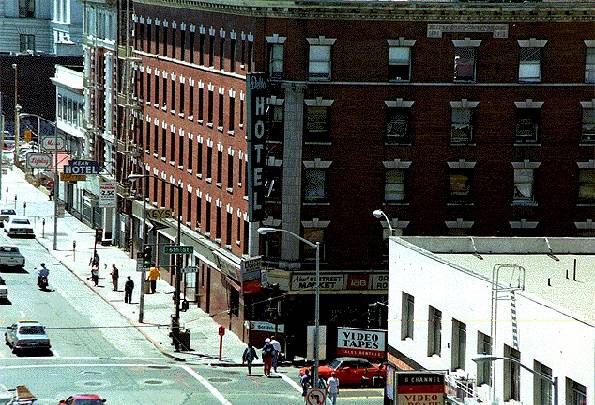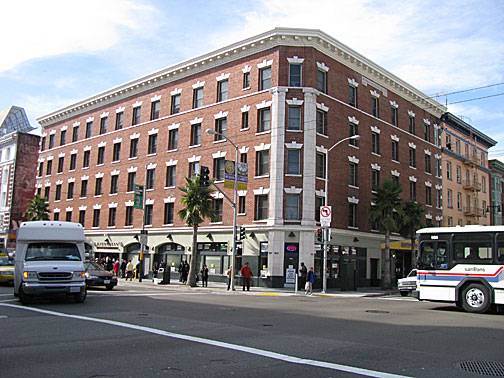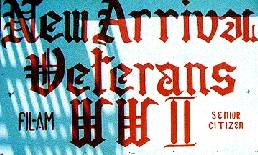SOUTH OF MARKET: Difference between revisions
m (1 revision(s)) |
(added article type) |
||
| (5 intermediate revisions by 3 users not shown) | |||
| Line 1: | Line 1: | ||
'''<font face = Papyrus> <font color = maroon> <font size = 4>Historical Essay</font></font> </font>''' | |||
''by James Sobredo'' | |||
[[Image:filipin1$delta-hotel-and-fil-am-center.jpg]] | [[Image:filipin1$delta-hotel-and-fil-am-center.jpg]] | ||
'''Fil-Am Senior Center in the Delta Hotel at 6th and Mission Streets.''' | '''Fil-Am Senior Center in the Delta Hotel at 6th and Mission Streets, 1998 above, and 2008 below.''' <br> ''Photo: Chris Carlsson'' | ||
[[Image:bayanihan-house-former-delta-hotel_0244.jpg]] | |||
"I remember that there were lots of Filipinos living in the South of Market," recalls Rudy Delphino, a 62 year-old Filipino American who now works as an employment specialist at West Bay Pilipino Multi-Service Inc.. Delphino's family started out living in North Beach. "Then a lot of Filipinos moved to the South of Market, and we wanted to go where there were people we knew, so we just followed along." Filipino families lived on streets such as Natoma, Tehama, Russ, and Minna. Eventually many Filipino families moved further out to [[fillmore filipinos | When people think of the Filipino community in San Francisco, the area around Kearny Street and Jackson usually comes to mind. This was especially true in the early-1920s and 1930s when numerous Filipino restaurants, lunch counters, barbershops, pool-halls, and coffee shops were located around the Kearny Street area. This "[[MANILATOWN|Manilatown]]," however, was occupied mostly by Filipino bachelors and migrant workers. Filipinos who had families did not live in "Manilatown." Married Filipinos lived with their wives and families in the South of Market area ("SOMA"). | ||
"I remember that there were lots of Filipinos living in the South of Market," recalls Rudy Delphino, a 62 year-old Filipino American who now works as an employment specialist at West Bay Pilipino Multi-Service Inc.. Delphino's family started out living in North Beach. "Then a lot of Filipinos moved to the South of Market, and we wanted to go where there were people we knew, so we just followed along." Filipino families lived on streets such as Natoma, Tehama, Russ, and Minna. Eventually many Filipino families moved further out to [[fillmore filipinos | the Fillmore District]], the Mission, and [[DALY CITY: THE NEW FILIPINOTOWN | Daly City]]. | |||
But the Filipino community never completely disappeared. | But the Filipino community never completely disappeared. | ||
[[Image:filipin1$filam-veterans-center.jpg]] | [[Image:filipin1$filam-veterans-center.jpg]] | ||
Closeup of the "FilAm Veterans Center" sign on the Delta Hotel, 6th and Mission. | '''Closeup of the "FilAm Veterans Center" sign on the Delta Hotel, 6th and Mission.''' ''Photo: James Sobredo'' | ||
[[José Rizal's Quarantine and the Nightmare of Imperialism | Prev. Document]] [[Galleons and ‘Indios’ | Next Document]] | |||
[[ | [[category:Filipino]] [[category:SOMA]] [[category:1920s]] [[category:1930s]] [[category:1990s]] | ||
Latest revision as of 20:47, 28 February 2024
Historical Essay
by James Sobredo
Fil-Am Senior Center in the Delta Hotel at 6th and Mission Streets, 1998 above, and 2008 below.
Photo: Chris Carlsson
When people think of the Filipino community in San Francisco, the area around Kearny Street and Jackson usually comes to mind. This was especially true in the early-1920s and 1930s when numerous Filipino restaurants, lunch counters, barbershops, pool-halls, and coffee shops were located around the Kearny Street area. This "Manilatown," however, was occupied mostly by Filipino bachelors and migrant workers. Filipinos who had families did not live in "Manilatown." Married Filipinos lived with their wives and families in the South of Market area ("SOMA").
"I remember that there were lots of Filipinos living in the South of Market," recalls Rudy Delphino, a 62 year-old Filipino American who now works as an employment specialist at West Bay Pilipino Multi-Service Inc.. Delphino's family started out living in North Beach. "Then a lot of Filipinos moved to the South of Market, and we wanted to go where there were people we knew, so we just followed along." Filipino families lived on streets such as Natoma, Tehama, Russ, and Minna. Eventually many Filipino families moved further out to the Fillmore District, the Mission, and Daly City.
But the Filipino community never completely disappeared.
Closeup of the "FilAm Veterans Center" sign on the Delta Hotel, 6th and Mission. Photo: James Sobredo



